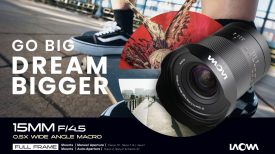
I’ve had the Panasonic Varicam LT since the beginning of April and I’ve put it to work in some news stories for Al Jazeera English and BBC. I’m also planning to use it for a documentary at the end of May. I’m going to divide this field test blog in two or three parts, so I can update it while I get to know the camera.
The LT is a smaller Varicam35 with the same sensor as its big brother. Resolutions of 4K up to 50/60p, HD up to 200/240p and recording in different AVC and ProRes codecs depending on the frame rate chosen. It has a dual ISO mode of 800 and 5000, that on paper is supposed to have very low noise. And 14 stops of dynamic range when using Panasonic’s V-Log.
This camera falls in the same market segment as the Sony F5 and the Canon C300 Mark II. The bodies of these three cameras have a similar price tag at around $16,000 US, but of course each of them requires accessories to be ready to shoot. I did a simple Excel table to see what would be the final package price of each camera in a similar configuration of shoulder mount system, 512GBs of media, EF mount and enough batteries for a day’s shoot:
- Sony F5: $21,000 US
- Canon C300 mark II: $22,000 US
- Panasonic Varicam LT: $25,000 US
My previous main camera was an original Canon C300, and I have been considering for months which camera to get to replace it. I found a good deal for the LT and decided to go for it.
First impressions
Count slowly from one to sixteen… Please do it. It feels long right? That’s how long it takes to switch on the new Panasonic Varicam LT. Sixteen long seconds. And that is the very first impression the new user gets from this camera. Is this a problem? Well, depending on the kind of shooting you do, it is. And keep in mind the camera needs to be rebooted every time you change resolutions, codecs or frame rates. So the long wait gets multiplied quite a lot at the end of the day if you are changing from normal speed to slow motion, for example. I’m sure I’m going to miss shots due to this.
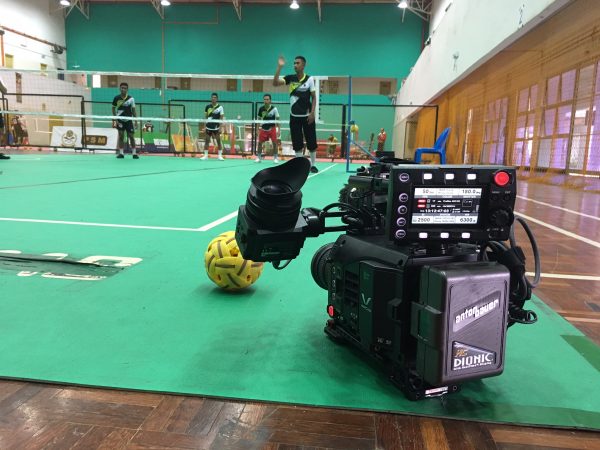
The other thing that surprises the first time user is the control panel at the rear of the camera. All the camera functions are controlled and monitored there. Personally I would have preferred to have it integrated in the body, but I’m guessing Panasonic made it detachable to allow ACs to control the camera while the DOP or operator has it on the shoulder. The six buttons on top and bottom of the screen allow quick access to the basic functions that need to be controlled during filming: frame rate, color profile, resolution, ISO, audio and white balance. Those functions can also be controlled through the EVF, but that involves getting deep into the menu. One of the most annoying things about the camera is the fact audio levels can only be controlled with the rear panel, and as you can imagine that’s quite inconvenient for solo operators.
The control panel can also be used to navigate through the recorded clips, and play them. During playback I do miss the traditional dedicated buttons for play, forward, rewind and pause. Each of those functions is controlled through the dial instead, but there is no indication if you are rewinding fast or slow, and the timecode info display is tiny.
The camera feels great on the shoulder. But keep in mind it’s quite heavy (although nowhere near as heavy as the full sized Varicam 35). Body, EVF, shoulder pad, grip and battery weight almost 8kg, that’s without a lens. It would be much better balanced if it were less tall, but overall it’s a camera that sits nicely on the shoulder. Overall the camera feels super strong, and should withstand years of field torture – the parts that feel more flimsy are the cables between EVF and camera, the P2 card door and the rear control panel.
Lens Mount
The Varicam LT comes with an EF mount by default. The user can buy an optional PL mount and change it without the need to send the camera to the service center. I haven’t tried the PL option yet, so I’ll only talk about the EF one here.
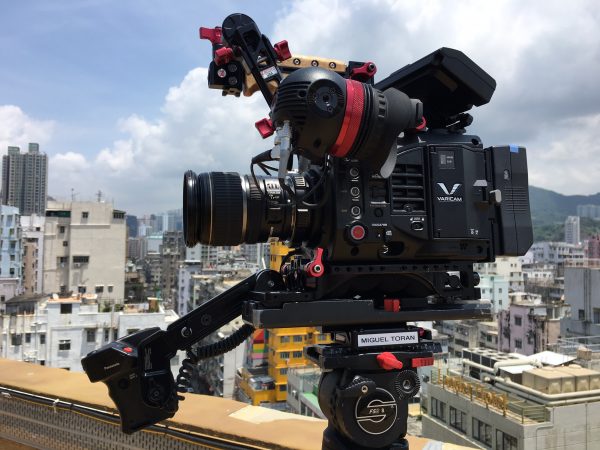
This is an EF positive lock mount, so there is no play between the mount and the lens. Heavy lenses like telephotos, Canon CN primes and zooms, or the CN7 will benefit greatly of this. The only drawback of the positive lock mount is that you need two hands to change a lens, where with the normal mount you can manage with only one. But overall it’s nice to have that solid connection between lens and camera. All the Canon lenses I have tried communicate without a problem with the camera. I have used other EF mount lenses from third party manufacturers and they work as well as the Canon ones.
You have full control of iris with the camera and grip dials, the stabilization works, and there is a one push auto iris option assignable to the user buttons.
EVF, Handle and top mounting options
One word describes the Panasonic VCVF10G viewfinder: expensive. At $5,400 US it’s almost the same price as the equivalent Sony OLED for the F5. So why this price tag and what are the alternatives? The Panasonic viewfinder connects to the camera through a 4 pin hirose cable and an SDI connector. Both connections are in the front of the camera, so you won’t have cables criss- crossing from front to rear. It has a very clear and crisp OLED display. And like the camera, it’s built like a tank.
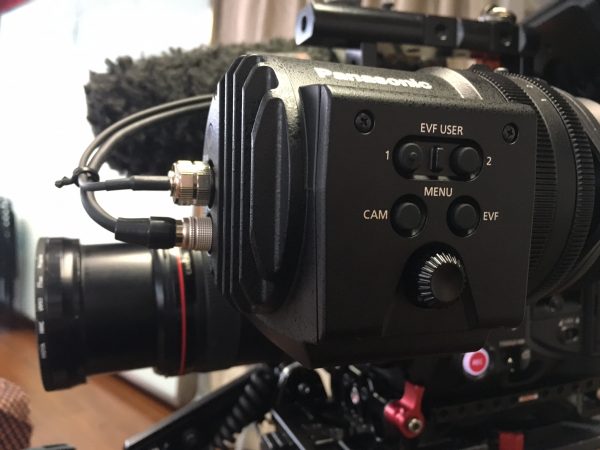
There’s one small dial, two user assignable buttons, and two buttons for CAM and EVF menu. If you press the EVF menu button only once you can change the brightness, colour, and peaking; and if you press it for two seconds you get into a deeper menu with other configuration options. The CAM menu button behaves similarly, one press and you can change frame rate, shutter speed, ISO, and white balance with the help of the small dial; two second presses and you get into the general camera menu which can be navigated with the small dial. The EVF has a proximity sensor that puts it to sleep once you move your face away from it.
The most similar third party alternative to Panasonic’s EVF would be the Zacuto Gratical Eye, because it can be powered from the camera without the need of external batteries. Right now the Zacuto gets power from the D-Tap connection in the rear battery plate, but I’m guessing soon there will be lemo to hirose cable options to plug it in the front. This will be a much better solution but the EVF will still drain your batteries.
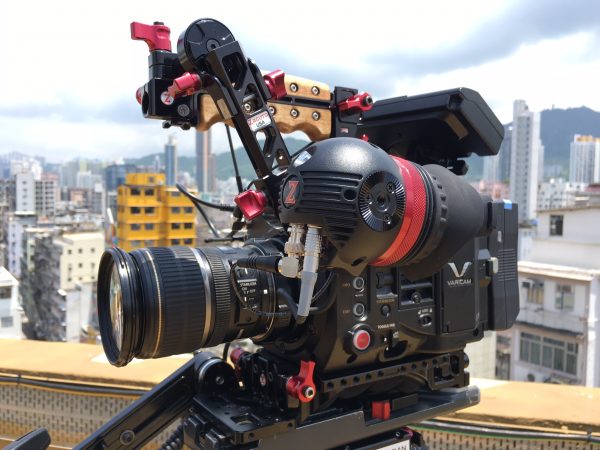
The Gratical Eye is half the price and less heavy. The only thing that you are losing with any third party EVF is the user assignable buttons, and the chance to control frame rate, ISO and white balance from the EVF. But you may assign these functions to other assignable buttons on the camera, and use the Gratical Eye’s joystick to quick access any of the EVF’s functions. For example Zacuto’s pixel-to- pixel function is more useful than Panasonic’s because it can be moved around the frame, whereas with Panasonic EVF it’s predetermined and there is no option of moving it while recording.
Another issue to take into account is that in hot and humid locations the Panasonic EVF gets fogged quite quickly, the Zacuto keeps clean for longer. So with so many things to consider, you can see that selecting an EVF for the Varicam LT is not an easy job.
The VF-SDI output carries all the information from the camera. And also the very useful Focus Squares tool, a setting that enables a focus assist setting where green squares enlarge when the object or subject is in focus. It’s not one hundred percent reliable, but a good tool to use combined with peaking and focus zoom.
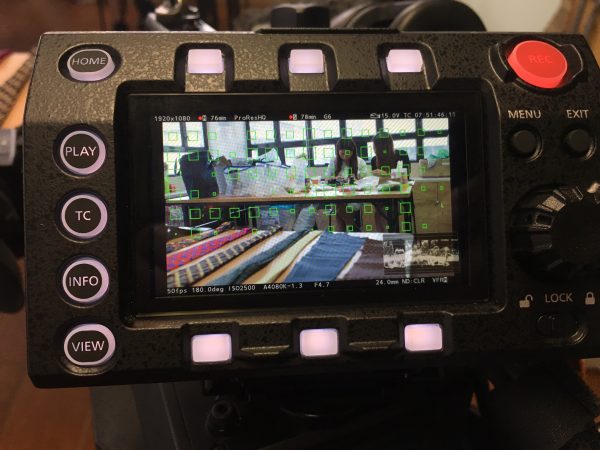
The camera’s top handle is a solid piece of metal. While it offers a good grip for easy handling, it has a few drawbacks. Besides not being very comfortable and too tall, my main complaint would be that you need an allen key and some spare time to unmount it – with the handle mounted the camera doesn’t fit in the camera bags or carry-on cases I usually use. Having to spend a few minutes screwing and unscrewing every time the camera needs to go inside a bag is a bit inconvenient. Accessory manufacturers are already designing top cheese plates for the LT, and that will allow for the use of other handles with quick release options.
Vocas, Wooden Camera and Zacuto offer similar cheeseplates and handle solutions. The Zacuto one is the only one I’ve tried, it has loads of mounting points for accessories, but unfortunately the Panasonic EVF can’t be easily mounted on it.
Media and codecs
One of the major criticisms of Panasonic cinema cameras is how expensive the proprietary media is. ExpressP2 cards have gone down on price in the last couple of months, now they cost $1,200 US for 256GB. Panasonic is also introducing a new generation of expressP2 called B Series, with error correction capabilities. I’ve only found the Japanese sale prices: the 256GB will be 1,300$ and the 512GB 2,300$. The expressP2 is thicker than the previous generations of P2 cards, and obviously it needs a new card reader that for now only Panasonic manufactures.
In the codecs department the LT offers loads of options. All the codecs are intra frame, and at least 10-bit 422. These are the codecs, bitrate and recording times in a 256gb expressP2 card:
HD
- ProRes 4444 – 121 min (240 mbps)
- ProRes 422 HQ 25p – 183 min (210 mbps)
- ProRes 422 HQ 50p – 91 min (384 mbps)
- AVC Intra 422 25p – 295 min (120mbps)
- AVC Intra 422 50p – 147 min (114mbps)
- AVC Intra 422 100p (in crop mode) – 73 min (114mbps)
- AVC Intra 444 25p – 144 min (211 mbps)
- AVC Intra 100 50i – 284 min (114mbps)
- AVC Intra LT 100p (in crop mode) – 146 min (51mbps)
- AVC Intra LT 200p (in crop mode) – 73 min (54mbps)
UHD
- AVC Intra 4K 422 25p – 82 min (388 mbps)
- AVC Intra 4K 422 50p – (220 mbps)
- AVC Intra 4K LT 25p – 147 min (196 mbps)
- AVC Intra 4K LT 50p – 73 min (207 mbps)
Editing all the footage that this camera can record is a bit tricky right now. Of course ProRes can be edited with almost any NLE, but the Varicam LT only records with it in HD up to 50/60p.
Avid and EDIUS Pro are listed in Panasonic’s workflow information website as the only NLEs that support all the AVC codecs. Premiere CC can import AVC-I 422 and 444 in HD/4K, but not AVC-LT. And FCPX can import AVC-I 422 in 4K, and AVC-I 444 in HD; but for some reason doesn’t work with AVC-I 422 in HD. FCPX also doesn’t read AVC-LT.
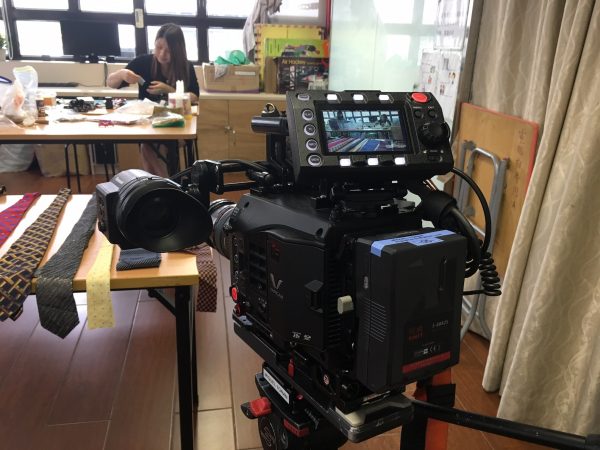
AVC-LT is the codec I am having more problems with. It’s the one you can use if you are shooting HD between 100 and 240p, or 4k 50/60p. Even though AVID supports it, I get an error every time I want to transcode a clip, or export a sequence. So it’s quite difficult at the moment to use this codec in any of the major NLEs. Even with Davinci Resolve, which supports it in theory, there is terrible pixelation when importing this file type. So at the moment, the only workaround for using AVC-LT files is to use Panasonic Viewer Plus (license is $120 US) and export the files as DPX, to import them later into whichever NLE you are using. Quite an inefficient workflow.
Also keep in mind Panasonic’s P2 Viewer only reads AVC files, and not ProRes. So if your card has a mix of both codec families, you won’t be able to monitor all of them from the same software. Panasonic should work harder with what calls its ‘4K Workflow Partners,’ I hope soon all the codecs will be fully supported by Premiere and FCPX.
In the next post I’ll focus on the picture quality, slow motion capability, dual ISO, V-LOG mode and audio recording…



